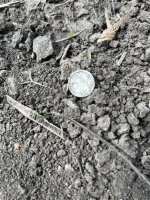rakoom2002
Tenderfoot
- Mar 12, 2013
- 8
- 0
- Primary Interest:
- All Treasure Hunting
Hello everyone. Im pretty new to metal detecting, I bought a Bounty Hunter Tracker IV and went out once and then came home and upgraded to a
Garrett Ace 250 because of the good reviews. I've been running into a couple super frustrating issues.
1. Phantom Signals: Ill be scanning and get a really good signal, keep going back and forth, moving different angles and directions and keep getting a solid signal, ill dig my plug and then scan the plug and nothing, scan the hole and surrounding area and nothing. A variation of the prior mentioned experience is when Ill do the same thing but scan the plug and itll ring up again with a solid signal, and then ill start tearing into the plug and partioning it. Ill then scan the pieces again and the signal disappears, rescan everything, the sod, the dirt, and the hole and the signal disappears. Its very odd and happens pretty often. I've tried turning down the sensitivity even and it still seems to happen fairly frequently.
2. Roots: Ive noticed that roots have set off the detector more than once for a solid coin signal (cant remember which one) but the signal is always super strong. Ill dig down and get into some super tough dirt because of thick roots. Ill go to the point where ill completely dig all around the roots and scan the root and itll continue to set off the detector. Its very odd. Im afraid to scan near trees now because ive been burnt by this so many times even though ive heard trees are good areas to scan because people sit against them when its nice out.
Anyways, I would greatly appreciate any light you guys could shed on this. Thank you!
Garrett Ace 250 because of the good reviews. I've been running into a couple super frustrating issues.
1. Phantom Signals: Ill be scanning and get a really good signal, keep going back and forth, moving different angles and directions and keep getting a solid signal, ill dig my plug and then scan the plug and nothing, scan the hole and surrounding area and nothing. A variation of the prior mentioned experience is when Ill do the same thing but scan the plug and itll ring up again with a solid signal, and then ill start tearing into the plug and partioning it. Ill then scan the pieces again and the signal disappears, rescan everything, the sod, the dirt, and the hole and the signal disappears. Its very odd and happens pretty often. I've tried turning down the sensitivity even and it still seems to happen fairly frequently.
2. Roots: Ive noticed that roots have set off the detector more than once for a solid coin signal (cant remember which one) but the signal is always super strong. Ill dig down and get into some super tough dirt because of thick roots. Ill go to the point where ill completely dig all around the roots and scan the root and itll continue to set off the detector. Its very odd. Im afraid to scan near trees now because ive been burnt by this so many times even though ive heard trees are good areas to scan because people sit against them when its nice out.
Anyways, I would greatly appreciate any light you guys could shed on this. Thank you!









